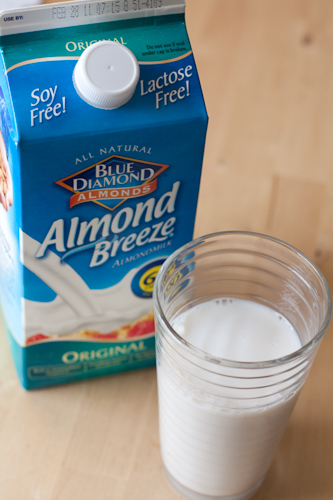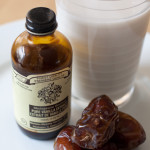Choice. We love it. And these days, there seems to be an abundance of it in the dairy case. Now, in addition to your standard cow’s milk choices (organic, low fat, fat-free, lactose–free), there is a slew of alternatives that aren’t even dairy at all: soy milk, almond milk, rice milk, oat milk, coconut milk, even hemp milk. (Really, people? Hemp milk? Maybe I need to open up my chakras a little, but the idea of dunking my Oreos in a tall glass of hemp milk is about as appealing as chewing on some hippie’s patchouli-scented dreadlocks.)
I like my vanilla soy latte as much as the next girl, but I’d never use soy milk as an everyday milk substitute. Too much aftertaste, not enough creaminess. Almond milk, though, the new darling of health foods, is another story. It has a pleasant neutral milky taste to it, with just a hint of nuttiness. And, the texture is full and thick, mimicking the feel of whole milk pretty well.

Almond Breeze almond milk
Almond milk is made from ground almonds that are mixed with water, plus vitamins, stabilizers, and in some cases, a sweetener like evaporated cane juice. You can make your own homemade almond milk by soaking almonds overnight, then blending with water and straining the solids, but that can get expensive and probably isn’t worth all the effort.
Before converting, I decided to do a little research to see what the fuss was all about. Is almond milk really that much better for you? What are the problems with it that no one is talking about? Here’s the DL on almond milk:
The Health Benefits
- It’s full of nutrients and good stuff. Almonds are a rich source of protein, Vitamin E, magnesium, potassium, selenium, manganese, and iron. This means strong bones and muscles, antioxidant protection, healthy skin, high energy levels, good metabolism, and other health benefits. Also, commercially made almond milk is often fortified with calcium (A good tip: give the carton a good shake before drinking, because calcium can settle at the bottom). Almond milk contains no cholesterol, and has actually been shown to lower levels of LDL cholesterol (due to good monounsaturated fats in almonds) as well as protect against heart disease (almond skins contain flavonoids which help to protect the heart).
- It’s low in calories. Based on a recent comparison published in The Wall Street Journal, a one-cup serving of almond milk comes in at 60 calories, compared to coconut milk (80 calories), soy milk (90 calories), rice milk (120 calories), and 2% cow’s milk (130 calories).
- It’s lactose free. An estimated 30 to 50 million Americans (about 25% of the United States population) are affected by lactose intolerance, meaning they have difficulty digesting the sugar found in cow’s milk.
- It’s antibiotic and growth hormone free. While many dairy farmers have made strides to ensure that their cows are rBGH-free, the practice of injecting dairy cows with growth hormones and antibiotics has not been completely eradicated.
- It’s an alternate alternative. Soy milk got some bad PR not long ago thanks to Jeremy Piven’s man boobs. Unless you’re consuming a gallon of soy milk a day though, studies have shown that soy-induced man boobs aren’t a real concern. However, there is an ongoing debate on the effect of soy foods on women. Soy foods are rich in isoflavones/phytoestrogens, which can mimic the effects of estrogen. It is currently unclear whether soy foods affect breast cancer risk or recovery…reading the studies and articles on this topic can easily spin you around with all the seemingly contradictory findings. It appears that the conclusion most widely agreed upon is to consume soy in moderation, along with a healthy and balanced diet. Thanks, Captain Obvious.
The Concerns
- It can cause problems for those at risk for low thyroid function. Almonds are a goitrogenic food, meaning, when consumed in large quantities, they can suppress the function of the thyroid gland by interfering with iodine uptake, causing an enlargement of the thyroid. While goitrogenic foods (such as soy, cabbage, kale, flax, broccoli, and almonds) can be harmful for those with thyroid problems, they are beneficial for people who have healthy thyroid function. So, if you have a thyroid problem, avoid almond milk. Otherwise, your almond milk mustache is good to go.
- It has added sugar. Flavored almond milk like Vanilla and Chocolate can have 15-22 grams of sugar per cup. To avoid all that extra sugar, opt for Original (7 grams sugar) or Unsweetened (0 grams sugar) flavors, both offered by Almond Breeze and Silk PureAlmond.
Now, don’t get me wrong, almond milk will never replace real dairy for me. I love my cheese and butter and ice cream too much. For goodness sake, I was happily raised on bottles of fresh whole milk from our local dairy farm. But, as a healthy alternative, I can get behind using almond milk in my morning smoothies, eating my granola with it, even making some sauces and soups with it. What’s your take on almond milk? Friend or Foe?

Ingredients for Vanilla-Date Smoothie
Adapted from the Bon Appétit Test Kitchen
This sweet and creamy smoothie taste too good to be good for you…but it is! Love the hit of fragrant vanilla, the bits of caramelly dates, and the blended ice with the almond milk makes a great icy milky consistency.
Ingredients
- 1 ½ cups almond milk (Original flavor)
- 4 pitted Medjool dates
- 1/2 teaspoon vanilla extract
- 10-12 ice cubes (a few big handfuls)
- Sprinkle of cinnamon (optional)
Instructions
- Blend everything together until smooth.
Recipe Source: LickMySpoon.com.
Hello! All images and content are copyright protected. Please do not use our images without prior permission. If you want to republish this recipe, please re-write the recipe in your own words, or simply link back to this post for the recipe. Thank you!
This post was originally published on KQED’s Bay Area Bites on January 19, 2011.
This recipe is brought to you by LICK MY SPOON
http://lickmyspoon.com/recipes/got-almond-milk/
